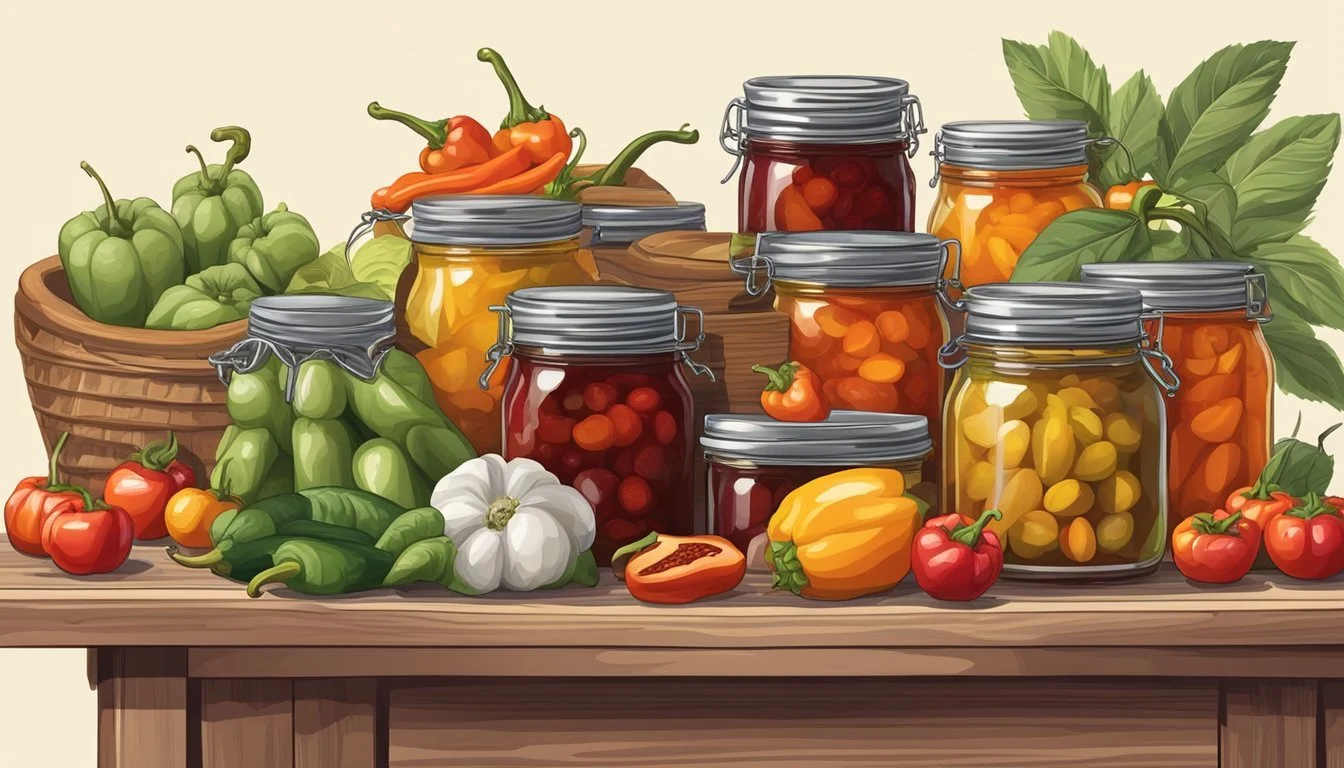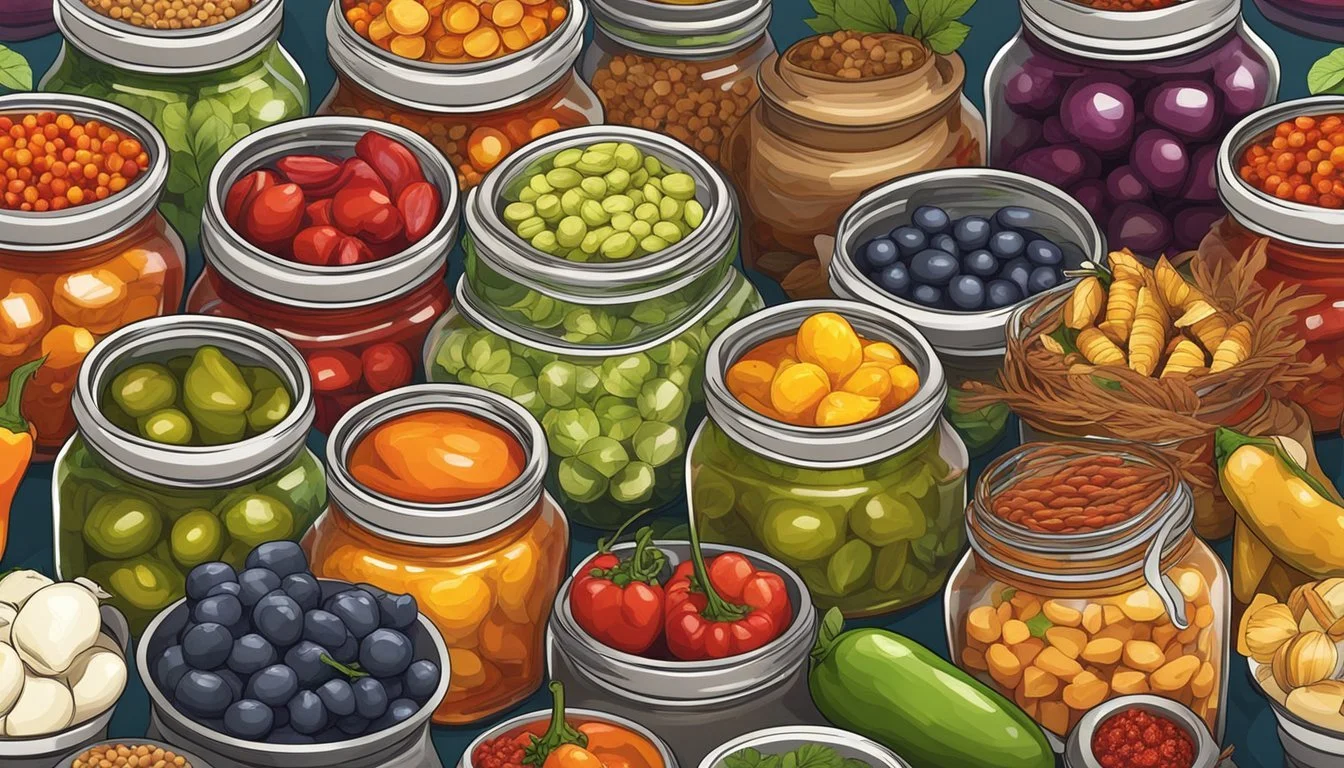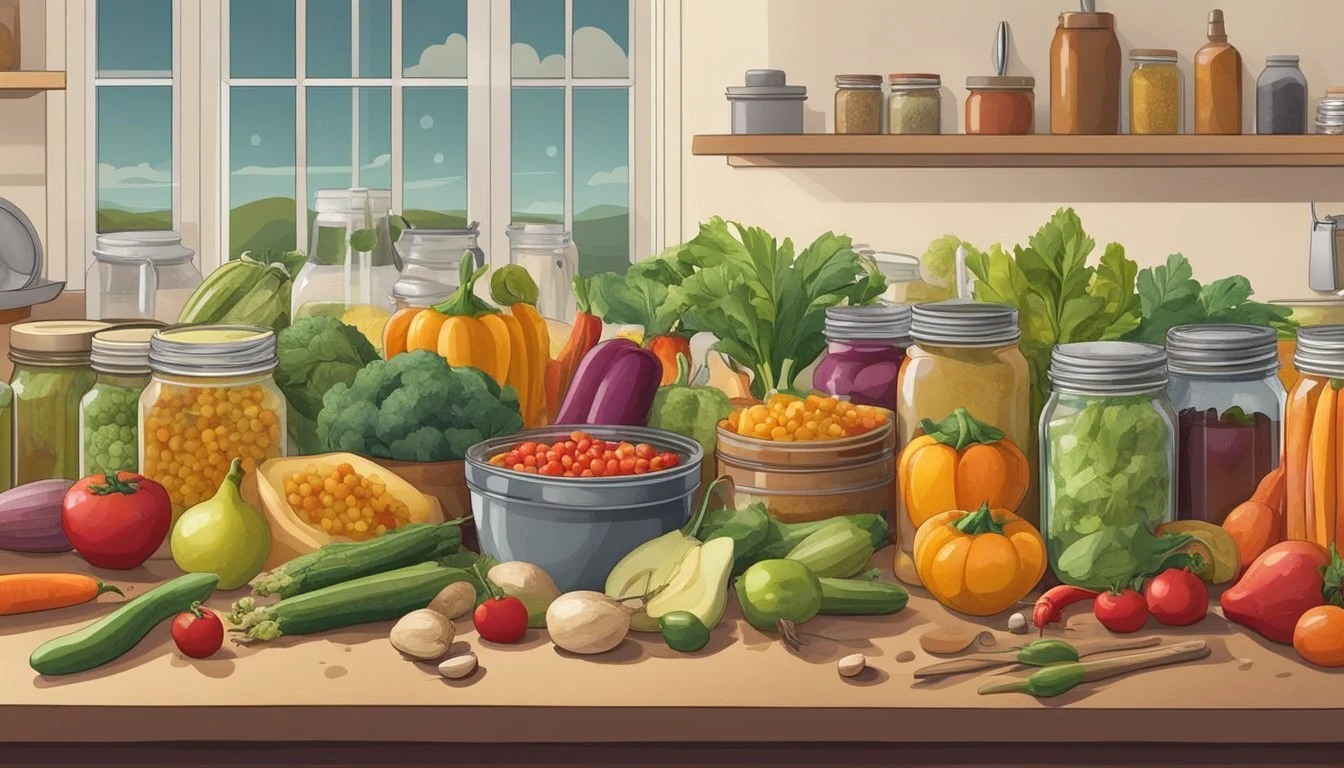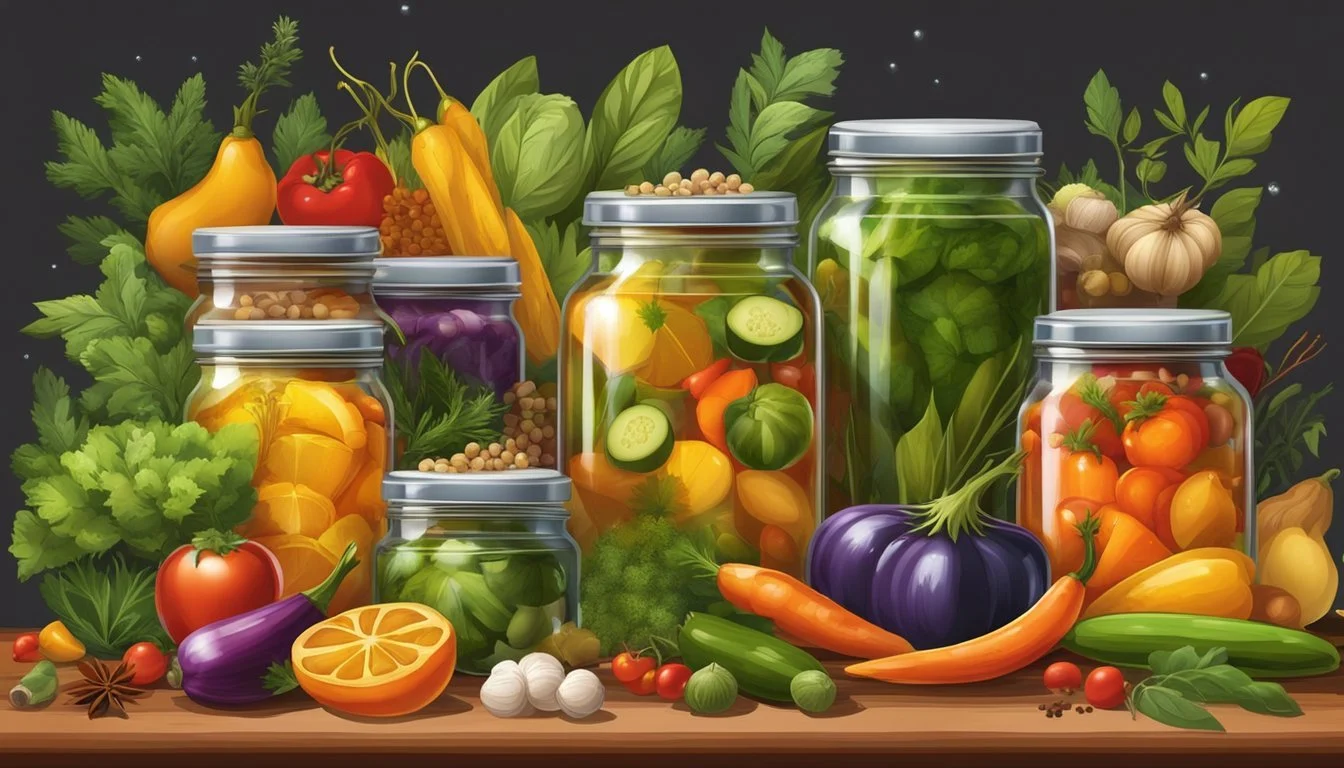Swicy Canning Techniques
Mastering Sweet-Spicy Preserves
In the realm of home canning and flavor innovation, "swicy" has emerged as a popular trend. This term, a blend of sweet and spicy, celebrates the fusion of sugary notes with a kick of heat. Preserving such exciting flavor combinations offers enthusiasts a chance to enjoy their favorite swicy concoctions year-round. Recipes revolve around the use of seasonal fruits and vegetables, combined with spices and peppers to capture the essence of swicy in jars. The key is to find the perfect balance that pleases the palate without overwhelming it.
The concept of sweet and spicy is not new to the culinary world; however, giving it a distinct identity under the moniker 'swicy' has revitalized the way these flavors are perceived and used in the kitchen. The canning process allows these flavors to meld and intensify over time, resulting in a more complex taste experience. Preserving swicy flavors involves understanding the nuances of each ingredient, ensuring that the sweetness does not overpower the spiciness and vice versa, to create a harmonious blend that is both invigorating and enjoyable.
Adventurous home canners are experimenting with a variety of ingredients, such as pairing mango with habanero or honey with sriracha, to develop new swicy profiles. These bold combinations can be used to add a zesty twist to traditional dishes, served as condiments, or even enjoyed straight from the jar. Through careful preparation and a respect for the ingredients' natural flavors, canners can craft preserves that are not only delicious but also shelf-stable, allowing the swicy trend to take its place in pantries everywhere.
The Basics of Swicy Canning
Swicy canning involves preserving the unique balance of sweet and spicy flavors that can enhance a variety of dishes. This section will explain the fundamentals of capturing these flavors through canning, focusing on flavor profiling, the canning process, necessary equipment, and safety protocols.
Understanding Swicy Flavor Profiles
The swicy flavor profile is a dynamic blend of sweetness and spiciness. Popular swicy combinations include chocolate with chili and hot honey. To achieve a satisfying swicy preserve, consider the balance of ingredients like sugar, which provides sweetness, and spices or peppers, which contribute heat. The right proportions will depend on personal taste and the specific characteristics of each ingredient.
Introduction to Canning
Canning is a method of food preservation where food is processed and sealed in an airtight container. Water bath canning is suitable for high-acid foods, like most swicy recipes, since the acid makes it harder for bacteria to survive. Pressure canning reaches higher temperatures and is necessary for low-acid foods. For swicy recipes, a mixture of vinegar, sugar, and salt in water bath canning creates an environment inhospitable to bacteria while enhancing the flavor.
Essential Canning Equipment
To start swicy canning, the following equipment is essential:
Canning jars: Glass jars designed for canning due to their heat resistance.
Lids and bands: Ensures a tight seal, preventing spoilage.
Jar lifter: Safely handles hot jars.
Water bath canner: A large pot for processing jars in hot water.
Canning funnel: Minimizes messes during filling.
Slotted spoon: Useful for removing air bubbles and managing ingredients.
Each tool plays a crucial role in the process, ensuring both quality and safety of the canned products.
Safety and Sterilization
Safety is paramount in canning to prevent foodborne illnesses. Sterilize all jars, lids, and tools by boiling them in water or heating them in an oven. Ensure all equipment is free from cracks and defects. The hot water bath method processes jars in simmering water for a specific amount of time, which varies by recipe. Always use a tested recipe to ensure proper acidity and sugar content for preservation stability.
Preparation and Ingredients
Preserving sweet-spicy combinations, commonly known as "swicy," requires meticulous preparation and the selection of high-quality ingredients. This section provides a clear path to ensure a successful canning experience.
Selecting Quality Ingredients
Choosing fresh, crisp vegetables is crucial for the best canned goods. For sweet and spicy pickles, seek out firm cucumbers, and for a broader flavor profile involve spicy peppers, tangy onions, and aromatic garlic. Fresh dill can also be added for an extra layer of complexity. The fresher the vegetables, the crisper and more delightful the preserved product will be.
Pre-Canning Preparation
Before starting the canning process, one should thoroughly clean and dry all vegetables. Cutting them into uniform sizes ensures even flavor absorption and cooking. The jars and lids must be sterilized to prevent contamination. The prep time typically ranges from 20 to 30 minutes, with cook time varying based on the recipe, leading to a total time from start to finish of approximately 1 hour.
Creating the Swicy Brine
The brine is a delicate balance of sweet and spicy elements, typically made from a base of white vinegar or apple cider vinegar. Granulated sugar brings sweetness, while kosher salt acts as a preservative. To achieve the swicy signature, one may add cayenne pepper or other spices for heat. A sample brine recipe could include:
Apple cider vinegar: 1 cup
White vinegar: 1 cup
Granulated sugar: 1 cup
Kosher salt: 1 tablespoon
Cayenne pepper: 1 teaspoon
Combine the ingredients and bring the mixture to a boil, then simmer to fully dissolve the sugars and salts, creating the perfect sweet-spicy milieu for pickling.
Canning Process
The canning process is essential to preserve the flavors of sweet and spicy combinations, ensuring airtight seals and long-lasting storage. Careful attention must be paid to filling the jars, sealing, processing, and checking the seals to maintain the quality and safety of the canned products.
Filling the Jars
When filling the jars, one should ensure that the recipe's ingredients are well-prepared and at the right temperature. It is critical to pack jars with the prepared ingredients leaving the proper headspace, which typically ranges from 1/4" to 1/2" depending on the recipe. This space allows for the expansion of food during processing and helps create a vacuum seal. Jars should be filled methodically to avoid air pockets, and it's important that the rims of the jars are clean to ensure a good seal.
Sealing and Processing
After filling the jars, one must place the lids on and screw the bands down until they are finger-tight. The jars are then carefully placed into the water bath canner with water covering at least one inch over the lids. The water bath canning method is suitable for acidic foods and involves submerging sealed jars in hot water and boiling them for a set amount of time, known as the processing time. This step is crucial to kill any bacteria and seal the jars properly.
Processing Times:
Sweet & Spicy Salsa: Process for 10-15 minutes.
Spicy Pickles: Process for 10 minutes.
Testing Jar Seals
Once the jars have been processed and removed from the water bath canner, they need to cool down for 12 to 24 hours. One should check the seals by pressing down on the center of the lid; if the lid does not pop up and down, it is sealed properly. If a jar hasn't sealed correctly, it should be refrigerated and used first. Properly sealed jars should be stored in a cool, dry place, away from direct sunlight, and can be enjoyed for months to come.
Recipes and Variations
This section provides readers with definitive recipes and innovative ideas for creating the perfect balance of sweetness and spiciness in their homemade pickles and condiments.
Classic Sweet and Spicy Pickle Recipe
The recipe for classic sweet and spicy pickles marries the crunchiness of pickling cucumbers with a brine that's a harmony of sugar and vinegar. Bold flavors such as mustard seeds, celery seed, and red pepper flakes add depth and heat, while the sugar tempers the spice, creating a complex profile that appeals to various palates.
Ingredients:
1 pound pickling cucumbers, sliced
1 cup white vinegar
1 cup water
1 cup granulated sugar
1 tablespoon mustard seeds
1 teaspoon celery seed
1 teaspoon red pepper flakes
Instructions:
In a pot, combine vinegar, water, and sugar. Stir until the sugar dissolves.
Add mustard seeds, celery seed, and red pepper flakes to the brine mixture and bring to a boil.
Pack the cucumbers tightly into jars.
Pour the hot brine over cucumbers, leaving a ½ inch headspace.
Seal the jars and process in a water bath canner for 10 minutes.
Yield: About 2 pints
Total Time: 1 hour
Innovative Swicy Pairings
For those seeking to venture beyond traditional recipes, here are two exciting sweet and spicy pairings:
Chocolate Chili Ketchup: Combining rich chocolate with the heat of chilies creates a ketchup that's both luscious and fiery. Ideal for enhancing burgers or as a standalone dip.
Ingredients:
1 can (28 ounces) tomato puree
1/4 cup unsweetened cocoa powder
1/2 cup brown sugar
1/4 cup white vinegar
1 tablespoon sriracha or other hot sauce
1 teaspoon onion powder
Salt to taste
Instructions:
Mix tomato puree with cocoa powder, brown sugar, and vinegar.
Stir in sriracha, onion powder, and salt.
Cook over medium heat until the ketchup thickens to the desired consistency.
Sriracha Honey Mustard: For a condiment with a kick, combine the tang of mustard with the sweetness of honey and the unmistakable fire of sriracha.
Ingredients:
1 cup yellow mustard
1/4 cup honey
1/4 cup sriracha sauce
Instructions:
Blend mustard, honey, and sriracha in a bowl.
Adjust the ratios to taste for more sweetness or heat.
Experimenting with these recipes and variations allows for a customized approach to creating swicy condiments and pickles. Whether one adheres to the essential elements of classic recipes or embraces the daring combinations of innovative pairings, the result is sure to add an impressive homemade touch to any table.
Serving and Pairing Ideas
The fusion of sweet and spicy flavors, often referred to as "Swicy," adds a unique twist to various meals. The key to incorporating these flavors lies in creative pairings that enhance the eating experience.
Swicy Accompaniments for Meals
Swicy condiments are versatile, adding a delightful kick to everyday dishes. Here are some specific ways to introduce Swicy flavors to meals:
Dinner: A dollop of sweet and spicy chili ketchup can transform a traditional meatloaf or grilled chicken breast into something special.
Sandwiches: Elevate turkey or chicken sandwiches with a spread of hot honey or sriracha-spiked ketchup for a balance of sweetness and heat.
These bold pairings serve not only to please the palate but also to complement the core flavors of the meal.
Suggested Uses for Swicy Condiments
Beyond their use in cooking, Swicy condiments make excellent additions to various aspects of dining and entertaining:
Charcuterie Boards: Include small bowls of sweet and spicy pickles or onion marmalade to contrast with the savory flavors of cured meats and cheeses.
Ketchup Alternatives: Replace plain ketchup with a chili or sriracha-infused variety to add complexity to fries, burgers, and potato wedges.
Whether it's through a subtle hint of heat or a noticeable sweet undertone, these suggestions are designed to elevate one's culinary experience.
Storage and Shelf Life
When it comes to preserving sweet-spicy combos like sweet and spicy pickles, understanding proper storage methods and the shelf life of canned goods ensures both the safety and quality of these delightful preserves.
Proper Storage Tips
Once the canning process is complete, sweet-spicy preserves should be stored in a cool, dark place such as a pantry or a cellar. They recommend keeping jars away from direct sunlight as it can deteriorate the quality of the food over time. The jars should be checked to ensure that the seals are tight; the contents should not be consumed if the seal is compromised.
Pantry: Keep at a consistent temperature between 50-70°F (10-21°C).
Refrigerator pickles recipe: If it's a refrigerator pickle, store it in the fridge immediately after cooling and sealing.
For preservation of quality, the following are recommended:
Store jars upright to avoid disruption of the seal.
Avoid stacking jars, as it may contribute to seal failure.
Label each jar with the date of canning to keep track of the preservation date.
Understanding Shelf Life
The shelf life of sweet and spicy pickles, and other canned goods, largely depends on the canning method and conditions under which they are stored. Home canned goods generally maintain optimal flavor and quality for up to one year when stored properly. They remain safe to eat beyond that time period if the jar remains sealed, but quality may decline.
One should always inspect the jars before consuming:
Safety Checks:
Check for off odors or colors, which indicate spoilage.
Ensure the lid has not bulged or rusted, as that suggests contamination.
Best Before: For peak flavor, consume within the first year, although many preserves last longer.
The shelf life for refrigerator pickles is shorter, typically lasting up to 1-2 months in the fridge. Unlike pantry-stored preserves, refrigerator pickles must be kept refrigerated at all times.
Nutritional Information
This section explores the health implications and nutritional makeup of swicy canned goods, covering both the benefits and specific nutrient content.
Health Benefits of Pickling
Pickling vegetables in a combination of sweet and spicy brine can enhance their nutritional value. The pickling process preserves the vegetables and can add probiotics that support digestive health. Vegetables such as cucumbers, carrots, and peppers retain most of their vitamins and minerals through the pickling process. They are rich sources of Vitamin A, Vitamin C, and potassium, which are vital for maintaining good health.
Breaking Down the Nutritional Content
A typical serving of swicy pickled vegetables (What wine goes well with pickled vegetables?) contains a diverse range of nutrients. Below is a simplified breakdown of an approximate nutritional content per 1 cup serving:
Calories: 15-30
Carbohydrates: 4-6g
Of which sugars (from the sweetening agent): 2-4g
Fiber: 1-2g
Protein: 0-1g
Sodium: ~500-700mg (varies greatly with recipe)
Vitamins and Minerals:
Vitamin A: 10-20% of Daily Value (DV)
Vitamin C: 15-30% of DV
Calcium: 2-5% of DV
Iron: 2-5% of DV
Potassium: 3-7% of DV
It should be noted that homemade swicy canning allows for control over ingredients, resulting in customizable nutrition facts depending on the amount of added sugar and salt.
Troubleshooting and Tips
When canning sweet-spicy "Swicy" concoctions, ensuring the preservation of fresh flavors and textures is paramount. This section provides solutions to common canning issues and offers advice to enhance the swicy experience, focusing on crucial aspects such as jar preparation, seal integrity, and recipe clarity.
Common Canning Issues
Jar and Lid Preparation: To ensure a proper seal, jars must be free of nicks and food residue. Before filling, inspect each jar and lid for imperfections. Use only new lids for each batch as reused lids may compromise the seal.
Sealing Concerns: If a jar fails to seal, the contents are at risk. A seal might fail due to improper sealing surfaces or incorrect water bath canning procedures. It's advisable to reprocess the food within 24 hours with a new lid and a correctly executed water bath, following the same time recommendations.
Texture Preservation: For crisp textures, prevent overcooking. Swicy recipes should be quickly processed in a water bath canner to maintain the crispiness of the produce. Overcooking leads to soft, less appealing results.
Avoiding Contamination: Sterilize canning equipment thoroughly. Contamination can spoil the batch and ruin the fresh flavors.
Enhancing the Swicy Experience
Batch Size: Small batch canning helps maintain consistency and quality in flavor and texture. With a swicy recipe, the balance of sweet and spicy is delicate; small batches make this balance easier to manage.
Fresh Ingredients: The fresher the ingredients, the better the final product. Fresh produce contributes significantly to the fresh flavors and crisp textures desired in swicy canning.
Recipe Clarity: An easy-to-make swicy recipe should include clear, step-by-step instructions. This clarity encourages successful results even for beginners and saves time.
By applying these troubleshooting tips and methods to enhance the canning experience, one can enjoy high-quality, swicy preserved foods that are delightful in flavor and texture.
Additional Resources
When delving into the world of swicy canning, enthusiasts may seek additional materials to enhance their expertise and locate the necessary tools. By engaging with comprehensive literature and identifying reliable supply vendors, canners ensure their sweet-spicy creations are both delicious and safely preserved.
Further Reading
"The Ball Complete Book of Home Preserving": This essential guide, often simply referred to as the Ball canning book, is a treasure trove for both novices and seasoned canners. It provides extensive knowledge on preserving techniques with a focus on safety and creativity.
Local Library: Often overlooked, one's local library can be an excellent source for canning books and magazines, offering information that ranges from beginner tips to advanced preserving techniques.
Where to Find Canning Supplies
Local Grocery Stores: Start here for basics like sugar, spices, and produce. Organic options are often available for those wanting to keep their canned goods as natural as possible.
Specialized Canning Retailers:
Canning Equipment Best For Canning pots and racks Preparing and processing canning jars safely Jars and lids Storing swicy concoctions Canning utensils Ensuring cleanliness and precision throughout
Home and Garden Stores: These retailers commonly stock a variety of canning equipment. Garden cucumbers and other fresh ingredients straight from the source can be found for an authentic homemade touch.
Online Marketplaces: A wide selection of canning supplies is just a click away, often offering bulk purchases and reviews to help inform decision-making.
Conclusion
The art of canning offers a delightful way to extend the enjoyment of swicy foods year-round. By understanding the balance between sweet and spicy, one can preserve a multitude of vibrant flavors. Canning swicy mixtures, whether it be jams, sauces, or chutneys, ensures that these bold tastes are just a pantry shelf away.
One should not underestimate the importance of using the correct techniques in canning to maintain the freshness and safety of the food. It is crucial to follow recommended procedures and guidance on food preservation to ensure that the sweet-spicy creations remain not only delicious but also safe to consume over time.
Key Takeaways for Swicy Canning:
Balance: It's vital to find the right ratio of sweetness to spice to please one's palate.
Technique: Proper sterilization and processing of the canning jars are non-negotiable steps.
Variety: The swicy flavor profile is versatile, allowing for a wide range of culinary applications.
Safety: Follow set guidelines to prevent the risk of foodborne illnesses.
By canning sweet and spicy combinations, chefs and home cooks alike capture the essence of swicy flavors. This practice allows them to savor the results of their culinary efforts well beyond the season of harvest. Whether it's the complexity of a swicy salsa or the subtle heat of a sweet chili glaze, the possibilities for creative preservation are limitless.









